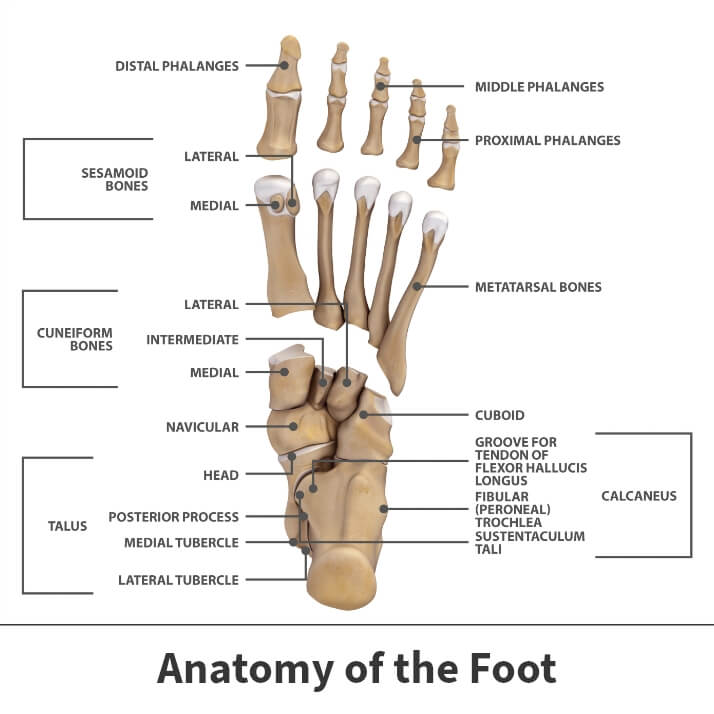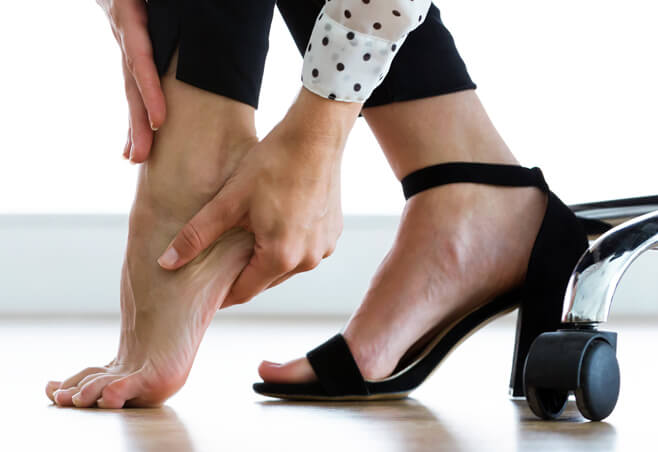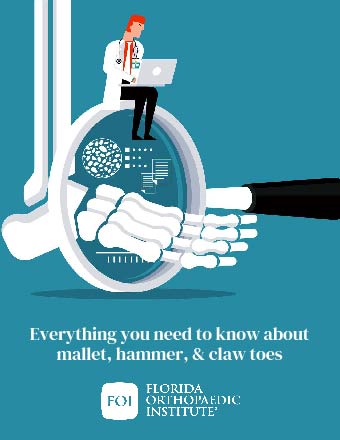Hammer, claw & mallet toes
Hammer, claw and mallet toes are all toe deformities that are usually caused by improper footwear. Besides deformities, other symptoms include redness and swelling, calluses, corns, and pain. There are both surgical and nonsurgical treatment options available for these toe conditions. Normally, surgical options are not considered unless the deformity is severe or if nonsurgical treatments are unsuccessful.
Anatomy

Aside from the big toe, each toe consists of three joints:
- Distal phalangeal joint (DP) – Joint at the end of the toe
- Proximal interphalangeal joint (PIP) – Joint in the middle of toe
- Metatarsophalangeal joint (MCP) – Joint at the base of the toe
About
Hammer, claw and mallet toes are all toe deformities that are often caused by wearing shoes that do not fit properly. When shoes do not fit, the toe muscles are forced to remain in a fixed position. Over time, these muscles will lose their ability to stretch out, resulting in these toe deformities. Toe deformities are also caused by trauma, bone and muscle imbalances, and arthritis.
In mallet toe, the DP joint buckles and the skin near the tip of the toenail develops a corn that can eventually result in an ulcer.
Mallet toe can happen to any toe, but since the second toe is typically the longest, it is most likely to be affected.
A hammer toe occurs when the second, third, or fourth toes bend at the PIP joint. Hammer toe is often accompanied by corns or calluses on the top of the PIP joint or on the tip of the toe. If not treated, the toes lose their flexibility over time and become fixed.
Claw toe is a bit different from the other deformities as it can also be the result of nerve damage caused by diseases such as diabetes or alcoholism, which can potentially weaken the foot muscles. In claw toes, the toes bend and dig into the soles of the shoe, resulting in calluses.
Symptoms
Mallet, hammer, and claw toes can all be characterized by redness and swelling, corns, calluses, difficulty walking, and pain. But they each have their own unique symptoms that set them apart from one another.
- Mallet toes look like a mallet (they will bend unnaturally at the top toe joint) and can develop toe ulcers – an open sore on the foot.
- Hammer toes bend downward at the middle joint and prevent the flexing of the foot and movement of toes.
- Claw toes look like claws (the toes bend upward from the joints at the ball of the foot and downward at the middle joints).

Diagnosis
Your Florida Orthopaedic Institute physician will analyze your symptoms and your overall health to determine your diagnosis. Specific tests may also be required to confirm that there are no neurological disorders that can weaken the foot muscles.
Treatment
There are both surgical and nonsurgical treatments available for mallet, hammer, and claw toes. Surgical procedures are only considered when nonsurgical treatments are exhausted, and symptoms have not improved.
Nonsurgical treatments
Nonsurgical treatments for mild to moderate cases of mallet, hammer, and claw toes are all treated similarly. The treatment starts off with new shoes that have soft, roomy toe boxes. Some exercises may also be recommended to help stretch and strengthen the toe muscles. Your physician may also recommend products to help reduce corns and calluses, as well as non-steroidal anti-inflammatory medication such as Advil and Motrin (ibuprofen) or Aleve (naproxen) to help reduce pain and swelling.
Surgical treatments
Surgical treatment is only recommended if the mallet, hammer, and claw toes are severe, or if nonsurgical treatments were unsuccessful. Claw and hammer toes can both be treated with arthroplasty – the surgical reconstruction or replacement of a joint. In hammer toes, the arthroplasty is done in the DP joint by removing one side of the joint, releasing the tension on the tendons and ligaments around the joint. The toe can then be realigned into its proper position. A metal pin or stitches are used to help keep the toe in the correct position during the healing process.
The procedure for claw toes is the same except the arthroplasty is done in the PIP joint, but depending on the severity of the claw toe, the tendons and ligaments in the MCP joint may also need to be released.
For mallet toes, several procedures can be used depending on severity. If the deformity is extreme, DP joint fusion can be performed which consists of removing some of the bone in the DP joint with the rest of the joint fused together.

Read everything you need to know about hammer, claw and mallet toes is available in our free download.
Videos
Related specialties
- Achilles Calcific Tendinitis
- Achilles Tendon Rupture
- Achilles Tendonitis
- Ankle Fracture Surgery
- Ankle Fractures (Broken Ankle)
- Ankle Fusion Surgery
- Arthroscopic Articular Cartilage Repair
- Arthroscopy of the Ankle
- Bunions
- Charcot Joint
- Common Foot Fractures in Athletes
- Foot Stress Fractures
- Hallux Rigidus Surgery - Cheilectomy
- Hammer Toe
- High Ankle Sprain (Syndesmosis Ligament Injury)
- Intraarticular Calcaneal Fracture
- Lisfranc Injuries
- Metatarsalgia
- Neuromas (Foot)
- Plantar Fasciitis
- Sprained Ankle
- Total Ankle Replacement
- Turf Toe
